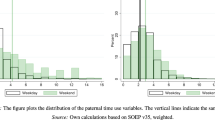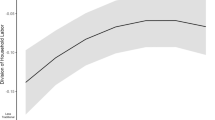Abstract
Existing evidence suggests that girls are differentially affected by income shocks and changes in bargaining power. Most studies, however, ignore household production and confound differential opportunity costs with changes in income or bargaining power. I disentangle these determinants of gender discrimination—preferences, income and time allocation—by comparing households with varying degrees of parental involvement. Results indicate that, controlling for household fixed effects, reducing the time available for household production has a disproportionately negative effect on daughters. But, for a transitory income shock, daughters’ education is less income-elastic. Increasing mothers’ bargaining power is most effective in narrowing the gender gap.

Similar content being viewed by others
Notes
It should be noted that these distinctions are specific to the analysis of children’s schooling, which cannot be easily hidden from others. Mothers may adjust some allocations to children when fathers are not present on a daily basis, but schooling decisions are more constrained as they can be easily monitored (see Chen 2009).
The mother’s preferences may be mediated by members of the extended family, e.g. parents and/or in-laws, after the father’s death. Identification requires only that the mother’s bargaining power increases after her spouse dies.
Limiting estimation to the SUSENAS, which covers all four groups, is not feasible given the rarity of widowhood and temporary migration among survey households.
The market rates of return to children’s skill units are not directly observable, thus they will also be subsumed in the household fixed effect. Provided that the gender gap in rates of return is exogenous to household type, conditional on the household fixed effect, this is not problematic. The estimated coefficient for the baseline girl dummy variable will also capture differences in the returns to human capital across males and females.
Time allocation data was only recorded in the IFLS for individuals aged 15 and older. Therefore, this sample is limited to children between the ages of 15 and 20.
References
Behrman J, Deolalikar A (1990) The intrahousehold demand for nutrients in Rural South India: individual estimates, fixed effects, and permanent income. J Hum Resour 25(4):665–696
Borjas G (1987) Self-selection and the earnings of immigrants. Am Econ Rev 77(4):531–553
Cameron L, Worswick C (2001) Education expenditure responses to crop loss in Indonesia: a gender bias. Econ Dev Cult Change 49(2):351–363
Chamberlain G (1980) Analysis of covariance with qualitative data. Rev Econ Stud 47(1):225–238
Chen JJ (2009) Identifying non-cooperative behavior among spouses: child outcomes in migrant-sending households. Mimeo, The Ohio State University
Dammert A (2010) Siblings, child labor, and schooling in Nicaragua and Guatemala. J Popul Econ 23(1):199–224
Dawson G (2008) Keeping rice in the pot. In Ford M, Parker L (eds) Women and work in Indonesia. Routledge, New York
Duflo E (1999) Grandmothers and granddaughters: old age pension and intra-household allocation in South Africa. World Bank Econ Rev 17(1):1–25
Edmonds EV (2006) Understanding sibling differences in child labor. J Popul Econ 19(4):795–821
Garg A, Morduch J (1998) Sibling rivalry and the gender gap: evidence from child health outcomes in Ghana. J Popul Econ 11(4):471–493
Gertler P, Levine D, Ames M (2004a) Schooling and parental death. Rev Econ Stat 86(1):211–225
Gertler P, Martinez S, Levine D, Bertozzi S (2004b) Lost presence and presents: how parental death affects children. Mimeo, University of California, Berkeley
Kochar A (1995) Explaining household vulnerability to idiosyncratic income shocks. Am Econ Rev 85(2):159–164.
Kochar A (1999) Smoothing consumption by smoothing income: hours-of-work responses to idiosyncratic agricultural shocks in rural India. Rev Econ Stat 81(1):50–61
Pitt MM, Khandker S (1998)The impact of group-based credit programs on poor households in Bangladesh. J Polit Econ 106(5):958–996
Pitt MM, Rosenzweig MR (1990)Estimating the intrahousehold incidence of illness: child health and gender-inequality in the allocation of time. Int Econ Rev 31(4):969–989
Qian N (2008)Missing women and the price of tea in China: the effect of sex-specific earnings on sex imbalance. Q J Econ 123(3):1251–1285
Rose E (1999)Consumption smoothing and excess female mortality in Rural India. Rev Econ Stat 81(1):1–49
Sen A (2000)Development as Freedom. Anchor, New York
Thomas D (1990a) Intrahousehold resource allocation: an inferential approach. J Hum Resour 25(4):635–664
Thomas D (1990b) Like father, like son; like mother, like daughter: parental resources and child height. J Hum Resour 29(4):950–988
United Nations Children’s Fund (2000) Equality, development and peace. UNICEF, New York
United Nations Educational, Scientific and Cultural Organization (2000) Education for all, 2000 assessment, thematic studies: girls’ education. UNESCO, Paris
Williams W (1991) Javanese lives: men and women in modern indonesian society. Rutgers University Press, Piscataway
Acknowledgements
I would like to thank Mark Rosenzweig, Michael Kremer, Erica Field, Sendhil Mullainathan, Mark Pitt and two anonymous referees for many helpful comments and suggestions. This work also benefited from discussions with Beatriz Armendariz, David Cutler, Dave Evans, Ed Glaeser, Bryan Graham, Caroline Hoxby, Claudia Goldin, Larry Katz, Lant Pritchett, Elaina Rose, Duncan Thomas, participants of the poster session at the PAA 2003 Annual Meeting, the 2004 NEUDC conference, and the Harvard University Development and Labor/Public Finance workshops. Support from the Project on Justice, Welfare and Economics at the Weatherhead Center for International Affairs and the Center for International Development at the Kennedy School of Government is gratefully acknowledged. All remaining errors are my own.
Author information
Authors and Affiliations
Corresponding author
Additional information
Responsible editor: Junsen Zhang
Appendix
Appendix
Rights and permissions
About this article
Cite this article
Chen, J.J. Dads, disease, and death: determinants of daughter discrimination. J Popul Econ 25, 119–149 (2012). https://doi.org/10.1007/s00148-011-0357-9
Received:
Accepted:
Published:
Issue Date:
DOI: https://doi.org/10.1007/s00148-011-0357-9




